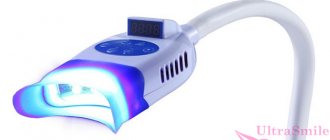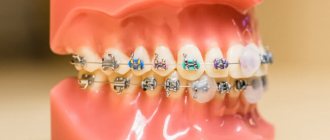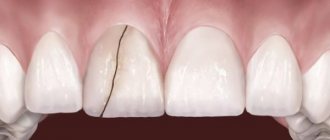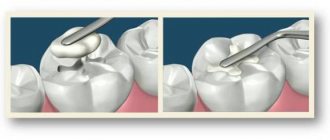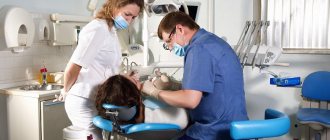900
Today, beautiful healthy teeth are not a fashion statement, but a necessity. A beautiful smile contributes to successful studies and career advancement.
All marketers claim that an attractive smile increases sales; psychologists assure us of the benefits of establishing comfortable relationships with people by having a friendly smile.
These are facts that force parents to pay closer attention to the condition of their children’s teeth, and adults to turn to dentists to correct aesthetic defects.
Cosmetic dentistry offers a wide range of methods and means to add charm and beauty to your smile. There are radical ones and not so radical ones.
The choice is always made by the client, but it would be nice to have at least a general idea of what is at stake. This article is devoted to a review of one of the fairly new and promising tooth-preserving areas of aesthetic dentistry - tooth separation.
Types and implementation
There are approximal (lateral) and coronary-radicular separation. The first is the prerogative of aesthetic dentistry, and the second is of curative dentistry.
The process of lateral separation consists of removing a layer of enamel, no more than ¼ millimeter thick, from the sides using special tools. If several molars are separated, sufficient space is created for further orthodontic manipulations. Grinding of tooth enamel is non-traumatic and painless.
Coronary-radicular separation is used for double-rooted units, when the tooth is divided in half, sparing the affected area between the roots. In this way, tooth extraction is avoided and its base is preserved for further prosthetics.
According to the specifics of the equipment for this procedure, the following types of separation are distinguished:
- Mechanical. In this case, the doctor uses abrasive burs, diamond burs, files, single-sided and double-sided discs to grind the enamel of bone organs.
- Physiological. Between the patient's teeth, the doctor fixes separation devices (wedges or threads), which remain in the interdental space for some time (usually a day, then a rearrangement is made).
In both cases, the goal of the procedure is achieved - moving the units apart and creating additional space between them. The mechanical procedure is more popular due to its accuracy and speed.
Classic separation ends with grinding of sharp corners and applying protective adhesive.
Important! All types of separation, at the request of the patient, are carried out using local anesthesia. Although the procedure is not as painful as it seems.
How to do it
Mechanical separation is carried out to grind the protruding areas of enamel in the areas of lateral contacts with adjacent elements of the dentition. About ¼ of the thickness is removed, since the average size of the enamel in the lateral zone is 2 mm. In some patients, this indicator may be higher or lower than normal.
Before grinding begins, soft and hard deposits are removed from the enamel, and the interdental spaces are thoroughly cleaned. The dentist calculates how many side surfaces need to be ground.
The doctor selects the tools for turning based on the available arsenal and the size of the area being treated. Sometimes grinding is carried out only in the lower, middle or upper part of the crown, and the remaining areas remain unused.
The most commonly used tools are:
- sanding file - strip;
- double-sided dental disc;
- single-sided separation disc;
- grinding attachments for drills.
During grinding, the doctor fixes the instrument with three fingers of the dominant hand, and with two fingers he provides support for the jaw bone or chin of the patient. With his left hand, the dentist pushes back the gums so as not to damage them. Sometimes he does this with the help of a special mirror, but if the doctor works with an assistant, then other devices can be used.
When the main areas are ground down, the stage begins to smooth out the resulting sharp corners, which can subsequently irritate the inner surface of the lips, cheeks or tongue when wearing braces. Then a special material is applied to the treated surfaces to prevent the destruction of the enamel.
Patients are often afraid of undergoing this procedure, worrying that it will be painful. In most cases, no pain appears, the sensations are comparable to the impact of a drill during anesthesia. Anesthesia is allowed only in certain cases when the patient has a strong fear of treatment.
The physiological separation method differs in the method and time of implementation. It is usually performed one day before installing braces. Separation wedges or threads are fixed between the teeth. After a day, the interval becomes such that the doctor can normally carry out all the necessary manipulations. In rare cases, physiological separation lasts two to three days.
Advantages
The main advantage and benefit of separation is the ability to preserve the tooth while providing sufficient space for maxillodental corrections, avoiding extraction (removal) even with very complex anomalies.
It is this method that allows you to very accurately calculate the size of the space required for correction.
No less significant advantages are:
- speed and relative painlessness;
- clear control of the formed interdental space;
- the ability to free up up to 8 mm of space on one jaw without depriving the patient of healthy teeth;
- no need to carry out any rehabilitation measures;
- safety and painlessness, but only if the procedure is performed by a highly qualified specialist.
Important! Separation is not always a panacea. In some cases, it is necessary to sacrifice a premolar, but this must be decided by the doctor.
Indications for orthognathic surgery and its cost.
We will discuss here in what situation a consultation with an orthodontist is necessary.
At this address https://orto-info.ru/ortodonticheskoe-lechenie/podgotovitelnyiy-period/metodyi-diagnostiki.html we will tell you what diagnostic methods exist in orthodontics.
Advantages and disadvantages
Teeth separation is becoming increasingly popular because it has important advantages:
- there is no need to remove healthy teeth to correct malocclusion and crowding;
- the procedure allows you to obtain enough space for manipulations to straighten the dentition, for installing dentures or teething;
- no rehabilitation period - after visiting the orthodontist, the patient can do his usual activities and not change his habits;
- there is no need to restore dental tissue;
- the procedure is painless, only discomfort may occur;
- the procedure does not take much time and is easy to carry out;
- when performed correctly, the absence of injuries to the mucous membrane and soft tissues, as well as other unpleasant consequences, is guaranteed.
Among modern orthodontic methods, separation is considered the most gentle procedure, which allows you to get rid of crowding without removing the lateral teeth.
Separation of teeth has no significant disadvantages, there are no significant restrictions for implementation and no unpleasant consequences. The only disadvantages include the following:
- increased sensitivity;
- violation of the integrity of the pulp;
- local inflammatory process of the gums.
Such phenomena usually arise due to an incorrectly performed procedure and low qualifications of the doctor. To avoid such troubles, it is necessary to approach the choice of a clinic and specialist with all responsibility. It is better to seek help from a doctor who has experience in performing such manipulations.
Flaws
The procedure has no disadvantages. Many people are scared by the very fact of removing a layer of enamel, however, it is so small that the patient does not even notice the difference before and after the procedure.
The thickness of the enamel reaches 2 millimeters and removal of less than 0.25 millimeters has virtually no effect on its density.
Numerous clinical trials confirm that after the procedure the enamel remains strong and externally undamaged.
During mechanical separation with a bur, the subdental areas of the gums can be damaged; to minimize this possibility, special retainers are used.
With proper preparation for separation, there should be no complications. The main thing is that the procedure must be carried out by a specialist, observing all the necessary requirements.
Important! Before the procedure, it is necessary to treat all teeth and sanitize the oral cavity, achieving maximum destruction of pathogenic flora.
Types of dental separation
Depending on the method of influencing tooth enamel, two types of separation are used in dentistry: mechanical and physiological. Both methods are easily tolerated by patients, without causing pain or discomfort. The choice of method of carrying out the procedure should be entrusted to the doctor.
Mechanical separation
Enamel grinding is done with special dental instruments - abrasive burs, discs, files. The dentist controls the volume of tissue removed at each stage of the procedure. The volume of ground enamel is determined for each patient individually. This is a priority method in modern dentistry.
Physiological separation
Special spacers are installed in the interdental spaces. They must be worn for up to 24 hours. There is no abrasive effect on the enamel, but achieving the result is more difficult. In this regard, the physiological technique is rarely used.
Possibility of complications
Complications during enamel grinding can only arise if the dentist makes a mistake or is insufficiently qualified, namely:
- death or damage to the pulp (tooth cavity);
- increased tooth sensitivity after the procedure;
- inflammation of the gum tissue when it is injured.
Important! Before the procedure in a reputable clinic, the patient will be asked to take an X-ray of the jaw in order to exclude individual deviations in the structure and location of the dental pulp, and not damage it during separation.
Important! By paying attention to the fixation of the doctor’s hands, the patient can himself draw a conclusion about his qualifications. When grinding a tooth, the professional fixes his right hand with the tip of the drill machine on the patient’s chin.
This position gives maximum precision when grinding. The doctor holds a dental mirror in his left hand and, by pushing back the soft tissues of the cheek, ensures that the procedure is not traumatic.
An increase in the reaction of teeth to hot and cold after the procedure is extremely rare in patients. An experienced dentist would not recommend this procedure for a client with demineralized thin enamel.
Rather, he will first recommend a course of intensive restoration of the enamel structure, and only then will consider the possibilities of separation or the use of other methods for correcting maxillodental anomalies.
Results of orthodontic treatment
Thanks to modern diagnostic and treatment methods, it has become possible to eliminate protrusion and straighten teeth without removing teeth. The facial profile has become more harmonious.
| Profile before treatment | Profile after treatment |
The duration of treatment was 14 months, the cost was 170,800 rubles.
The price of separation of one tooth varies from 400 to 600 rubles. The cost depends on several factors:
- clinics;
- specialist qualifications;
- region;
- methods and tools used.
Tooth separation is an excellent tooth-saving alternative to extraction.
This is a new word in orthodontics, which allows you to get straight teeth and a beautiful smile without losing healthy teeth.
Tooth separation is the creation of an aesthetic contour using dental equipment. The procedure is carried out in a dental office and is completely painless, using a protective covering for the treated areas.
The doctor makes a cut along the contour to separate the area from the rest. This procedure is necessary for the possibility of installing braces or, if necessary, orthodontic correction of teeth. The enamel is ground off, and the maximum depth of removal should be no more than 0.25 mm. This is necessary so as not to damage the sensitivity and integrity of the dental bone.
Many patients are concerned about a number of issues:
- in what cases is tooth separation necessary?
- consequences of the procedure;
- the effectiveness of this method.
The main advantage of separation is that this method of correction does not have negative consequences for the patient. With this method, any defects are corrected and all teeth are preserved. The procedure makes it possible to increase the space between teeth and correct abnormal jaw development in very difficult cases. For this purpose, special burs, files and other dental equipment are used.
At the consultation, orthodontist O.A. Baranova conducted an examination and made a diagnosis: crowding in the frontal part of the upper and lower dentition, protrusion of the upper and lower frontal teeth, narrowing of the dentition. There are also white spots on the teeth as a result of fluorosis, but this is a purely aesthetic problem that does not interfere with orthodontic treatment.
The patient was offered external braces or internal braces for orthodontic treatment. The cost of orthodontic treatment depends on the equipment chosen. To create space to correct the position of the front teeth, it may be necessary to remove premolars or separate teeth. We can say more accurately only after calculations have been carried out.
Before starting treatment, it is necessary to undergo additional examinations and consultations with related specialists. This is necessary for accurate diagnosis and development of a treatment plan.
As a result of the treatment, normalization of the shape of the dentition was achieved, and protrusion of the frontal group of teeth was eliminated.
The smile has become beautiful, the facial profile is ideal from all angles.
The cost of the orthodontic treatment was 170,800 rubles.
The duration of treatment is 14 months.
Separation is a procedure for separating teeth by reducing the thickness of the enamel layer.
For a long time, patients had to undergo a tooth extraction procedure before starting orthodontic treatment. This made it possible to free up space in the dentition. Today there is an alternative to this procedure – tooth separation. During separation, the doctor removes part of the enamel from the contact (side) surfaces of the teeth.
During separation, the doctor grinds down a certain number of teeth. Using diagnostic models and data from other studies, they calculate how much space is needed for the teeth to move freely. As a rule, this is a few millimeters. Teeth separation allows for up to 5 mm of free space for effective orthodontic treatment.
Indications
The advisability of using this procedure, which is gentle on teeth, is determined by the orthodontist, taking into account the general condition of the bone organs and the degree of necessary correction. General indications for separation:
- malocclusion;
- projecting or triangular anterior units;
- too dense dentition;
- crowding;
- erasing the cutting edge;
- installation of veneers;
- installation of bracket systems;
- indications for implantation.
When you need additional space between your teeth, go ahead with the procedure! But first, consult your favorite doctor.
How and with what is teeth separated for braces?
To process the protruding parts of the tooth, strips are used - special abrasive strips, or a thin fine-grained bur. It is believed that the latter provides greater accuracy and is more gentle on the patient.
But in practice, it turns out that the result is still determined by the skill of the orthodontist and the degree of coordination of his interaction with the assistant. When performing sedation, the nozzle must be firmly fixed, and at the same time it is necessary to protect soft tissues from injury using a mirror. Therefore, there is nothing to worry about if the teeth are carefully ground down when installing turnkey braces using strips. After roughing, the doctor will carefully sand all sharp areas.
But a physiological separation technique is also used. Separation wedges are placed in the gaps between certain teeth and fixed for a day. They provide the minimum space required by the orthodontist.
Recommendations
After the procedure, as mentioned earlier, no special restorative manipulations are required.
After grinding your teeth, you can apply a special glue to the enamel to protect it. At the patient's request, it is possible to undergo a course of enamel mineralization. Ask a doctor - he will tell you.
There’s no need to remind you, but we’ll remind you anyway. General recommendations for patients:
- It is necessary to undergo regular dental examinations, at least once a year;
- monitor the condition of the oral cavity (no one has canceled hygiene);
- rinse your mouth after eating foods with pigmented agents (coffee, tea, bright berries and juices, beets, etc.), especially if whitening is done;
- do not use your teeth for other purposes (there are bottle openers and nut crackers in the world) and give up the habit of grinding your teeth;
- don't forget about floss. The main enemy of our bone organs is bacteria in food debris between the teeth.
Teeth are not hair; they won’t grow back a second time. A caring attitude is the key to a healthy and beautiful smile for a successful person.
The purpose of dental wax for braces and whether to ignore its use.
In this article we will talk about correcting malocclusion in adults surgically.
Follow the link https://orto-info.ru/ortodonticheskoe-lechenie/osnovnoy-period/stomatolog-chto-jetot-vrach.html if you are interested in what a pediatric orthodontist treats.
Contraindications
Separation is a simple and convenient alternative to tooth extraction to ensure the formation of the necessary space between teeth. It is not always permissible to resort to this method. The list of contraindications can be presented as follows:
- the presence of carious lesions,
- development of pulpitis,
- inflammatory processes involving periodontal tissues,
- periodontal disease,
- pathologies of soft and hard tissues in the oral cavity.
In this case, before using the method, they resort to treatment of such pathologies. This condition will help to avoid the rapid spread of the pathological process throughout the dentition.
The operation is not recommended for people suffering from hypersensitivity of tooth enamel.
How much money do you need
Not a single decent clinic will calculate the cost of treatment for a patient over the phone. The total cost to a patient depends on many factors:
- scope of diagnostics;
- need for x-rays;
- the scope of the work itself;
- application of anesthesia and other services.
The region of residence of the patient and the qualifications of the doctor are important.
If you decide to take care of your loved one, look for a clinic in your city, choose a doctor who inspires your trust, and start working on improving your appearance. And then - there is no limit to perfection!
Forecast
When going to the dentist’s office, the patient hopes for comfortable and high-quality treatment, the doctor’s understanding and the desire to make every effort to restore and preserve the client’s teeth.
Separation is not yet a widely accepted tooth-preserving method for correcting defects of the maxillofacial region. However, when there is a shortage of space for adjacent units, this is the most effective way to obtain it.
For information on the separation of interdental spaces, watch the video.
